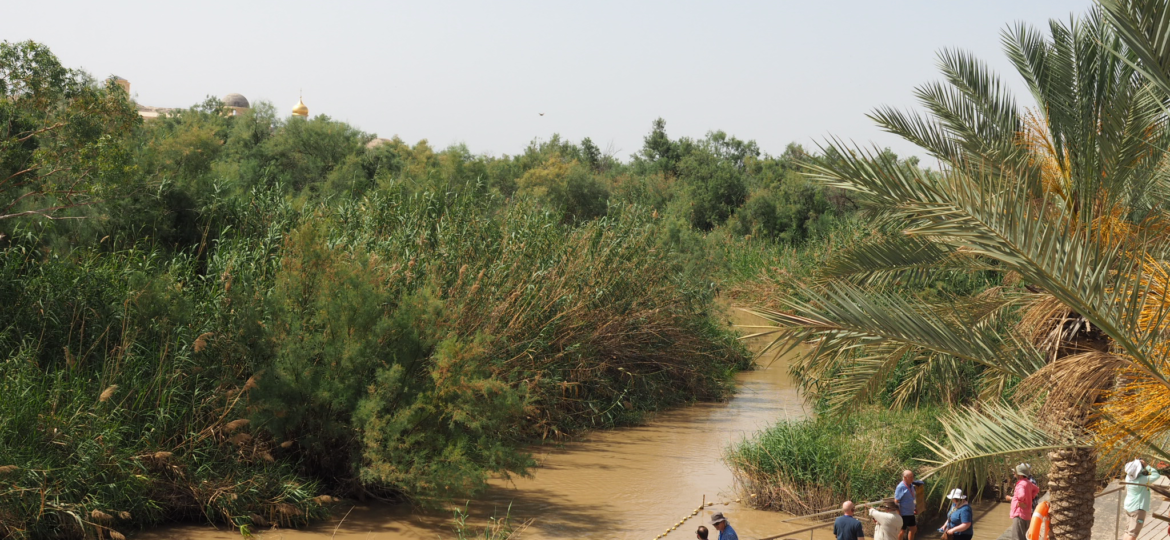
In today’s blog I would like to share with you a lesson from the landscape. What can we learn from the geography of the location where our Saviour was baptised?
Do we know where Yahshua was baptised? According to the gospel of Matthew, Yahshua was baptised in the Jordan River.
Then Jesus came from Galilee to the Jordan to John, to be baptised by him.
Matthew 3:13
The Gospel of John is more specific.
These things took place in Bethany across the Jordan, where John was baptising.
John 1:28
The baptism of Yahshua occurred at “Bethany Across the Jordan. “Across the Jordan” indicating that the site is located on the eastern bank of the river. Bethany Across the Jordan is also known as Bethany Beyond the Jordan.
Today this site is known as Al-Maghtas. It is located on the eastern banks of the Jordan River in the present day Kingdom of Jordan. On the Israeli side of the river, is the much larger, and more developed, pilgrimage site of Qasr el Yahud.
The Jordan River

The main headwaters of the Jordan River rise from three large springs at the base of Mount Hermon. Mount Hermon is part of the southern portion of the Anti-Lebanon range. It’s slopes mark the northern border of Israel.
From these three springs the Jordan River travels in a southerly direction passing through the Sea of Galilee. The river exits the Sea of Galilee in the south and continues its southerly trajectory, meandering through the Jordan Rift Valley before finally discharging into the Dead Sea.
Today the Jordan River forms a border separating the Golan Heights and the Kingdom of Jordan in the east, from the modern state of Israel and the West Bank to the west.
A Major River Crossing
Bethany Beyond the Jordan is not just a random sleepy little corner along the Jordan River. John was baptising at a major river crossing.
Here, at Bethany Beyond the Jordan, an ancient route connecting the Transjordanian Highway with the Coastal Highway in crosses the river.

The Transjordanian Highway skirts the the edge of the Arabian Desert, connecting Egypt in the south with Damascus and beyond in the North.
In the west, running parallel to the coastline, is the Coastal Highway, connecting Egypt with the the port city of Tyre in Phoenicia.
Connecting these two major trading routes is an east-west route that descended the Medeba Plateau near Mount Nebo, down into the Jordan Rift Valley, crossing the river at Bethany Beyond the Jordan, before continuing eastwards through Jericho, up into the Hills of Judah and onto the Central Benjamin Plateau on the western side of the Rift Valley, passing Jerusalem and eventually reaching the Coastal Highway.
The ancient route is still in use today. Today the Allenby Bridge, also known as the King Hussein Bridge, crosses the Jordan River just to the north of the crossing site.
Crossing Site of the Israelites
We know that the Israelites crossed the Jordan River at Bethany Beyond the Jordan when they entered the Promised Land under the leadership of Joshua.
- Before entering the Promised Land, the Israelites camped at Shittim in the plains of Moab (Joshua 3:1).
- 40 000 men of war crossed the Jordan River into the plains of Jericho (Joshua 4:14).
The only logical location for the crossing site is at Bethany Beyond the Jordan.
It is no coincidence that the location where Yahshua was baptised is the same as the location where the Israelites crossed the river.
Through His death and resurrection Yahshua leads us, His followers, into the Kingdom. In the same way Joshua lead the Israelites into the Promised Land after a national baptism in the Jordan River.
Joshua and the Israelites were a precursor to Yahshua and His followers.
The Deepest Point of the Earth
Bethany Beyond the Jordan is located 9 kilometres (5.6 miles) north of the Dead Sea. The shore of the Dead Sea is lowest point on earth, in terms of dry land.



We can therefore say that Yahshua’s baptism occurred at the lowest point on the earth.
Whilst technically speaking Bethany Beyond the Jodan can’t lay claim to being the lowest point it comes very close.
It is very difficult to baptise in the Dead Sea. The high salinity of the water causes our bodies to float, making a full immersion a challenge. Putting your head under the water here is also not a good idea… the extreme salinity is extremely painful in your eyes.
So I’m happy to equate Bethany Beyond the Jordan with the lowest point on earth for our purposes.
But why is it significant that Yahshua was baptised at the lowest point on earth?
The Significance of Mountains
To understand the significance of the location of Yahshua’s baptism we need to know something about what mountains meant to people in the ancient world.
In the ancient world mountains were considered as places where heaven and earth met. We see examples of God meeting His people in places like Mount Sinai and the Temple Mount in Jerusalem.
Mountains were therefore places where heaven and earth were close together.
With this understanding it naturally follows that at the lowest point on earth represents the point where heaven and earth are as far apart as possible. Whilst at the top of the mountain God and the people are close, at the lowest point of the earth they are as far removed from each other as possible.
The Take Away
The baptism of Yahshua at the location of Bethany Beyond the Jordan was a highly visible declaration, showing that no matter how far man has fallen from the presence of the Almighty God, no matter how grievous the sin, He will meet us there.
He will meet us at the lowest point of our lives, and through His eternal sacrifice provide a path to restoration and life.
[/et_pb_text][/et_pb_column] [/et_pb_row] [/et_pb_section]






